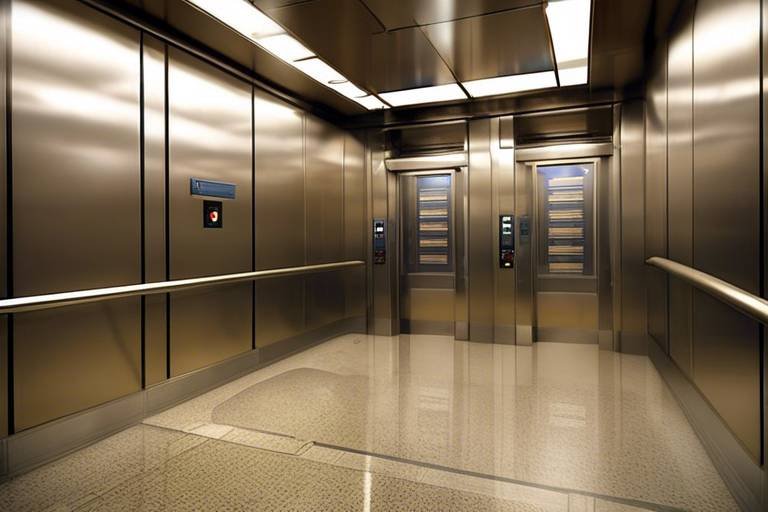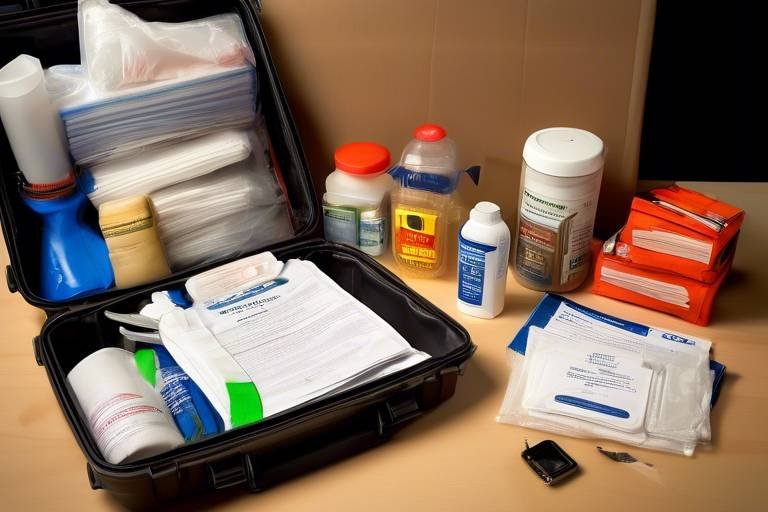Washing Machine Safety - Safety Tips to Consider
When it comes to household appliances, the washing machine is undoubtedly one of the most used, helping us tackle the never-ending pile of laundry. However, with great convenience comes great responsibility. It's essential to prioritize safety when using this powerful machine. Not only can improper use lead to accidents, but it can also shorten the lifespan of your appliance. In this article, we’ll delve into some crucial safety tips that will not only keep you safe but also ensure your washing machine operates efficiently for years to come.
Before we dive into the safety tips, it’s important to recognize that washing machines, like any other electrical appliance, come with their own set of hazards. Imagine a scenario where you’re loading your machine, and suddenly, you notice water pooling around the base. This can be a sign of a leak, which not only damages your flooring but can also lead to electrical hazards. Common risks associated with washing machines include:
- Electrical Issues: Faulty wiring or damaged cords can lead to shocks or fires.
- Water Leaks: Leaks can cause significant water damage and create slippery surfaces.
- Mechanical Failures: Worn-out parts can lead to malfunctions, posing risks during operation.
By understanding these hazards, you can take proactive steps to mitigate risks and enjoy a safer laundry experience.
Correct installation is the backbone of washing machine safety. It’s not just about plugging it in and calling it a day; following the manufacturer’s guidelines is crucial. For instance, did you know that placing your washing machine in a cramped space can lead to overheating? Ensuring adequate ventilation and access around the machine not only promotes efficiency but also minimizes risks. Here are some key points to remember:
- Follow the manufacturer's installation instructions. - Ensure proper electrical connections. - Maintain at least 4 inches of space around the machine for ventilation.
Let’s talk electrical safety, because this is where many accidents can happen. It’s vital to use grounded outlets to prevent shocks. Think of it like wearing a seatbelt in a car; it’s a simple yet effective way to protect yourself. Additionally, avoid overloading circuits, as this can lead to overheating and potential fires. Regularly inspecting cords and plugs for wear and damage is also a smart move. If you notice fraying or exposed wires, it’s time to replace them.
Investing in quality surge protectors can be a game changer for your washing machine. Power surges can occur without warning, and these little devices act like a safety net, protecting your appliance from sudden spikes in electricity. Just like having insurance for your home, surge protectors can save you from costly repairs or replacements.
While it might be tempting to use an extension cord to plug in your washing machine, it’s a big no-no. Extension cords can create significant hazards, including overheating and electrical fires. Always plug your washing machine directly into a wall outlet to minimize risks. It’s a small change that can make a huge difference in safety.
Regular maintenance is like a health check-up for your washing machine. Just as you wouldn’t ignore a persistent cough, you shouldn’t overlook your appliance’s needs. Cleaning filters, checking hoses for leaks, and inspecting the drum for foreign objects are essential tasks that can help prevent accidents and keep your machine running smoothly. Make it a habit to perform these checks every few months to ensure everything is in tip-top shape.
When it comes to washing machines, child safety is paramount. Children are naturally curious, and the laundry room can seem like an adventure waiting to happen. To keep your little ones safe, it’s crucial to secure the laundry area. This can include using childproof locks on doors and keeping detergents and other hazards out of reach. Remember, a little prevention goes a long way in ensuring your child’s safety.
Creating a safe laundry environment is essential for peace of mind. Consider these strategies:
- Install childproof locks on laundry room doors.
- Store detergents and cleaning supplies on high shelves.
- Keep the laundry area tidy to reduce tripping hazards.
By taking these steps, you can create a safer space that minimizes risks for your children.
Education is key when it comes to child safety. Teaching your kids about the dangers of the washing machine can help foster awareness and responsibility. Explain to them why they should never play around the machine when it’s in use and the importance of asking for help if they need something from the laundry room. It’s all about creating a culture of safety in your home.
1. How often should I perform maintenance on my washing machine?
Regular maintenance should be done every few months, but you should check hoses and filters monthly for any signs of wear or damage.
2. Is it safe to wash clothes with metal zippers?
Yes, but ensure that they are zipped up to avoid snagging on the drum. It’s always a good idea to check pockets for foreign objects before washing.
3. What should I do if my washing machine starts leaking?
Immediately unplug the machine and turn off the water supply. Inspect the hoses and connections for damage and consult a professional if needed.
4. Can I use fabric softener in my washing machine?
Yes, but make sure to follow the manufacturer’s instructions on the correct usage and amount to avoid residue buildup.
By keeping these safety tips in mind, you can enjoy a hassle-free laundry experience while ensuring the safety of your family and the longevity of your washing machine.

Understanding Washing Machine Hazards
When it comes to household appliances, washing machines are often seen as a mundane necessity, but they can harbor some serious hazards if not handled properly. Understanding these risks is crucial for maintaining a safe environment in your home. One of the most common dangers is electrical issues. Imagine a scenario where you’re tossing in a load of laundry, and suddenly, you hear a strange buzzing noise. This could be a sign of a malfunctioning electrical component that might lead to a shocking experience—or worse, a fire. Always remember, electrical mishaps can happen if the machine is not properly grounded or if the wiring is outdated.
Another significant risk is water leaks. A washing machine operates under high pressure, and any wear and tear on hoses can lead to leaks that not only waste water but also create slippery surfaces that can cause falls. If you’ve ever stepped into a laundry room and felt your feet slip on a wet floor, you know how dangerous it can be! Regularly inspecting hoses for cracks and ensuring they are securely attached can help mitigate this risk.
Mechanical failures also pose a serious threat. Overloading your washing machine might seem like a time-saver, but it can lead to significant wear on the drum and motor, potentially causing them to fail. This not only affects the performance of your appliance but can also result in costly repairs or replacements. It's like trying to fit a square peg into a round hole—eventually, something's got to give!
In addition to these hazards, it’s essential to recognize the importance of following safety guidelines. For instance, never ignore the manual that comes with your washing machine. It’s packed with valuable information on safe operation and maintenance practices. Also, be mindful of the area around your washing machine. A cluttered space can lead to accidents, especially if you have children or pets running around. Always keep the area clean and organized to minimize risks.
To sum it up, being aware of these potential hazards is your first line of defense in ensuring safety while using your washing machine. By recognizing the signs of electrical issues, being vigilant about water leaks, and avoiding overloading, you can significantly reduce the risks associated with this essential household appliance. Remember, safety is not just a precaution; it's a necessity!

Proper Installation Practices
When it comes to washing machines, proper installation is not just a matter of convenience; it's a critical step to ensure safety and optimal performance. Imagine trying to make a delicious meal in a kitchen that’s poorly organized—frustrating, right? The same logic applies to your washing machine. If it’s not set up correctly, you could face a myriad of issues ranging from leaks to electrical hazards. Therefore, following the manufacturer’s guidelines during installation is paramount. These guidelines are designed to provide you with a clear roadmap for a successful setup, ensuring that your machine operates smoothly and safely.
One of the first things to consider is the location of your washing machine. It should be placed on a level surface to avoid any unnecessary vibrations during the spin cycle. Uneven surfaces can lead to mechanical failures over time, and nobody wants that headache! Additionally, maintaining adequate space around the machine is essential for ventilation and access. Ideally, you should leave at least a few inches of space on all sides. This not only allows for proper air circulation but also makes it easier for you to reach the back of the machine for maintenance tasks.
Next up, let’s talk about electrical connections. It’s crucial to ensure that your washing machine is plugged into a grounded outlet. This means that the outlet should have three holes: two for the current and one for grounding. Grounding is vital because it protects against electrical shocks and helps to prevent potential fires. If you’re not familiar with electrical work, it’s best to hire a qualified electrician to handle this part. Trust me, your safety is worth it!
Speaking of electricity, let’s discuss the importance of avoiding overloading circuits. It might be tempting to plug multiple appliances into the same outlet, but this can lead to overheating and potential electrical fires. Instead, consider using dedicated circuits for your washing machine. This simple step can save you a lot of trouble down the line.
While we’ve covered the basics, there are a few additional considerations to keep in mind:
- Water Supply: Ensure that the water supply hoses are securely connected and not kinked. Leaking hoses can lead to significant water damage.
- Drainage: Make sure the drain hose is properly positioned to prevent backflow. A poorly installed drain can lead to messy situations!
- Leveling: Use a level to check that your machine is straight. Adjust the feet if necessary to prevent excessive shaking.
In summary, proper installation practices for your washing machine are essential for both safety and efficiency. Taking the time to follow these guidelines will not only help you avoid potential hazards but also extend the life of your appliance. Think of it as laying a solid foundation for a house; without it, everything else is at risk! Now that we’ve covered installation, let’s move on to an equally important topic: keeping your washing machine safe for children.
Q1: Why is proper installation important for my washing machine?
A1: Proper installation is crucial to ensure safety, prevent leaks, and avoid electrical issues. It sets the stage for optimal performance and longevity of your appliance.
Q2: What should I do if I’m not comfortable with electrical work?
A2: If you're unsure about electrical connections, it's best to hire a qualified electrician to ensure everything is set up safely and correctly.
Q3: How can I tell if my washing machine is properly leveled?
A3: You can use a level tool to check if your washing machine is straight. If it’s not, adjust the feet until it is level to avoid excessive vibrations.
Q4: Are there specific guidelines for water supply and drainage?
A4: Yes, ensure that water supply hoses are securely connected and not kinked. The drain hose should also be positioned correctly to prevent backflow.

Electrical Safety Measures
When it comes to using your washing machine, electrical safety should be at the top of your priority list. After all, this appliance is a significant part of your daily routine, and ensuring its safe operation can prevent potential hazards that may arise from electrical issues. First and foremost, always ensure that your washing machine is plugged into a grounded outlet. This simple step can make a world of difference in protecting both you and your machine from electrical shocks.
Moreover, it's crucial to avoid overloading circuits. Have you ever noticed how many devices are plugged into a single outlet? It’s like trying to fit too many clothes into a washing machine—eventually, something is going to give! To keep your washing machine running smoothly, try to dedicate a circuit specifically for it. This will not only enhance the performance of your appliance but also significantly reduce the risk of electrical fires.
Another essential aspect of electrical safety involves regularly inspecting the power cords and plugs for any signs of wear and damage. Just like you wouldn’t ignore a frayed rope when climbing a mountain, don’t overlook the condition of your washing machine's electrical components. Look for cracks, exposed wires, or any other irregularities, and replace them immediately if you notice anything unusual. This proactive approach can save you from potential disasters down the line.
Additionally, consider investing in quality surge protectors. Power surges can occur unexpectedly, often due to lightning strikes or fluctuations in the electrical grid. A good surge protector can act like a safety net for your washing machine, absorbing excess voltage and preventing damage. Think of it as a guardian that shields your appliance from the unpredictable nature of electricity.
Finally, it's vital to avoid using extension cords with your washing machine. While it might seem convenient to use one, extension cords can pose significant risks, including overheating and electrical fires. Just like you wouldn't use a flimsy ladder to reach great heights, don’t compromise on safety by using extension cords. Always plug your washing machine directly into a wall outlet to ensure optimal safety and performance.
- What should I do if my washing machine is making strange noises?
If your washing machine is making unusual sounds, it’s best to stop using it immediately and inspect it for any visible issues. Common causes might include foreign objects in the drum or mechanical failures. - How often should I check the electrical connections?
It's advisable to check the electrical connections at least once a year or whenever you notice any signs of wear or damage. - Can I use a power strip for my washing machine?
No, it’s not recommended to use a power strip or extension cord for your washing machine. Always plug it directly into a wall outlet for safety.

Using Surge Protectors
When it comes to safeguarding your washing machine, surge protectors are your best friends. Think of them as the unsung heroes in your home that quietly work behind the scenes, protecting your valuable appliances from the unpredictable nature of electrical surges. But what exactly are electrical surges? Well, they can occur due to various reasons, such as lightning strikes, power outages, or even the sudden activation of high-energy devices like refrigerators or air conditioners. These surges can send a spike of electricity through your home’s wiring, potentially causing significant damage to your washing machine and other electronics.
Investing in a quality surge protector is not just a good idea; it’s a necessity. By acting as a buffer, surge protectors can absorb excess voltage, allowing only the right amount of electricity to reach your washing machine. This not only extends the life of the appliance but also enhances overall safety in your laundry room. To ensure you choose the right surge protector, consider the following factors:
- Joule Rating: Look for a surge protector with a high joule rating, as this indicates how much energy it can absorb before failing.
- Response Time: A quick response time is crucial. The faster it reacts to a surge, the better protected your washing machine will be.
- Number of Outlets: Make sure it has enough outlets for your needs, but avoid overloading it with too many devices.
Moreover, it's essential to place your surge protector in a location that is easily accessible. This way, you can regularly check its status and replace it if it shows signs of wear or damage. Remember, surge protectors do have a lifespan, and after absorbing a few surges, they may no longer be effective.
In conclusion, using a surge protector is a simple yet effective way to shield your washing machine from electrical mishaps. Just like wearing a helmet while biking, it’s a precaution that can save you from costly repairs or replacements down the line. So, before you run your next load of laundry, take a moment to ensure that your washing machine is plugged into a reliable surge protector. It’s a small step that can make a big difference in keeping your home safe and your appliances running smoothly!
Here are some common questions regarding washing machine safety and surge protectors:
- Do all washing machines need surge protectors? Yes, it's advisable to use surge protectors for all washing machines to prevent damage from electrical surges.
- How do I know if my surge protector is still effective? Many surge protectors have indicator lights that show whether they are still functioning. If the light is off, it may need to be replaced.
- Can I use a surge protector with other appliances? Absolutely! Just ensure that you do not exceed the surge protector's maximum load capacity.

Avoiding Extension Cords
When it comes to washing machines, one of the most critical safety tips is to avoid using extension cords. You might think, "What’s the big deal? It’s just a little extra length!" But let’s break it down. Extension cords can be a tempting solution when your washing machine is too far from an outlet, but they can also introduce a range of hazards that could lead to serious problems.
Firstly, extension cords are not designed for long-term use with high-powered appliances like washing machines. These machines require a significant amount of electricity to operate efficiently, and extension cords simply can’t handle that kind of load over extended periods. Over time, this can lead to overheating, which increases the risk of electrical fires. Imagine your laundry room suddenly becoming a fire hazard just because you wanted to avoid a little rearranging!
Additionally, using an extension cord can create a tripping hazard. If the cord is lying across the floor, it can easily be overlooked, leading to accidents. You don’t want anyone, especially children or pets, to trip over a cord while doing laundry. And let’s not forget about the wear and tear that comes with frequent use. Cords can become frayed or damaged, which only adds to the risk of electrical shock or fire.
Instead of relying on extension cords, consider these safer alternatives:
- Rearranging Your Space: Move your washing machine closer to a wall outlet if possible. This might involve some heavy lifting, but it’s worth it for safety.
- Hiring an Electrician: If your laundry area lacks sufficient outlets, hiring a professional to install additional outlets can be a wise investment. This ensures that your appliance is plugged in safely and correctly.
- Using a Power Strip: While not a perfect solution, a high-quality power strip with surge protection can be a better alternative than an extension cord, as long as it is rated for heavy-duty appliances.
In conclusion, while extension cords might seem like a quick fix, they pose significant risks that can easily be avoided. Prioritizing safety in your laundry area not only protects your home but also extends the life of your washing machine. Remember, it’s always better to be safe than sorry when it comes to electrical appliances!

Routine Maintenance Tips
When it comes to keeping your washing machine in tip-top shape, routine maintenance is key. Just like a car needs regular oil changes, your washing machine requires consistent care to ensure it operates efficiently and safely. By dedicating a little time each month to maintenance tasks, you can prevent major issues down the line, saving yourself both time and money. So, let’s dive into some essential maintenance tips that will help keep your appliance running smoothly.
First off, one of the most crucial aspects of washing machine maintenance is cleaning the filters. Most washing machines come equipped with a lint filter or a pump filter that captures debris and lint from your laundry. If these filters become clogged, they can lead to poor performance and even potential flooding. To clean the filter, simply locate it—usually found at the bottom front of the machine—remove it, and rinse it under warm water to eliminate any buildup. This simple task can improve your machine's efficiency and prolong its lifespan.
Next, don't forget to check the hoses for any signs of wear and tear. Over time, hoses can develop cracks or leaks, which can lead to water damage in your home. It's a good idea to inspect the hoses at least every six months. Look for bulges, cracks, or any signs of moisture around the connections. If you notice any issues, replace the hoses immediately to avoid potential flooding. Remember, the cost of a new hose is far less than the cost of water damage repairs!
Another important maintenance tip is to inspect the drum for foreign objects. It’s not uncommon for small items like coins, socks, or buttons to get trapped in the drum or pump. Not only can these objects damage the machine, but they can also prevent your laundry from getting clean. To avoid this, always check your pockets before tossing clothes into the washer and periodically inspect the drum for any hidden items. If you do find something, remove it carefully to avoid damaging the drum.
Additionally, consider running a cleaning cycle on your washing machine every few months. Many modern machines come with a self-cleaning cycle, but if yours doesn’t, you can create your own. Simply fill the drum with hot water, add two cups of white vinegar, and run a normal cycle without any clothes. This helps eliminate odors, residue, and bacteria that can build up over time. Not only will this keep your machine smelling fresh, but it will also enhance its performance.
Finally, it’s essential to keep the exterior of your washing machine clean as well. Wipe down the surface regularly with a damp cloth to remove dust and detergent spills. This not only keeps your appliance looking new but also prevents the buildup of grime that can lead to bigger issues. Remember, a clean machine is a happy machine!
In summary, taking care of your washing machine doesn’t have to be a daunting task. By following these routine maintenance tips, you can ensure that your appliance remains safe, efficient, and ready to tackle your laundry needs. After all, a little preventive care goes a long way in extending the life of your washing machine!
Q: How often should I clean my washing machine's filter?
A: You should clean your washing machine's filter at least once every three months or more frequently if you do a lot of laundry.
Q: What should I do if I find a leak in my washing machine hoses?
A: If you find a leak, it's crucial to replace the hoses immediately to prevent water damage. Check your manufacturer's guidelines for the correct type of hose.
Q: Can I use bleach to clean my washing machine?
A: Yes, you can use bleach, but it's important to dilute it properly and ensure your machine is compatible with bleach cleaning. Always refer to your user manual for specific instructions.
Q: How can I prevent odors in my washing machine?
A: Regularly cleaning your machine, leaving the door open after use, and running a cleaning cycle with vinegar can help prevent odors.

Child Safety Precautions
When it comes to household appliances, washing machines can pose significant risks, especially for curious little ones. As a parent or guardian, ensuring the safety of children around these machines is not just a good idea; it’s a necessity. Children are naturally inquisitive, and they might see the washing machine as a fascinating place to explore. Therefore, taking proactive measures to prevent accidents is crucial. By implementing child safety precautions, you can create a safe environment while still enjoying the convenience of your washing machine.
One of the first steps in enhancing child safety is to secure the laundry area. This means making sure that the space where the washing machine is located is not only tidy but also free of potential hazards. Consider using childproof locks on the laundry room door or the washing machine itself. These locks act as a barrier, preventing children from accessing the machine unsupervised. Additionally, it’s essential to keep all detergents, fabric softeners, and other cleaning supplies out of reach. These substances can be dangerous if ingested, so storing them in high cabinets or locked containers is a smart move.
Moreover, it’s vital to educate children about the dangers associated with washing machines. Teaching them about the potential risks can foster a sense of awareness and caution. You can start by explaining how the washing machine works in simple terms, emphasizing that it’s not a toy. Use relatable analogies, such as likening the spinning drum to a rollercoaster ride that can be fun but also dangerous if they get too close. Engaging children in conversations about safety can make them feel included and help them understand the importance of respecting household appliances.
Here are a few key points to discuss with your children:
- Never play near the washing machine: Explain that the washing machine is not a play area and that they should stay at a safe distance while it’s in use.
- Don’t open the door while it’s running: Make sure they understand that the machine should not be opened while it’s in operation, as this can lead to accidents.
- Report any strange noises: Encourage them to let you know if they hear unusual sounds coming from the machine, signaling a potential issue.
Creating a safe laundry environment goes beyond just securing the area and educating children. It also involves staying vigilant. Always supervise young children when they are in or near the laundry area. A moment of distraction can lead to an accident, so it’s essential to keep a watchful eye. If you have older children, involve them in laundry tasks. This not only teaches them responsibility but also allows you to monitor their interactions with the machine and reinforce safety practices.
In conclusion, child safety around washing machines is a multifaceted approach that involves securing the area, educating children, and maintaining vigilance. By taking these precautions, you can ensure that your laundry routine remains safe and efficient while giving you peace of mind that your little ones are protected from potential hazards.
Here are some common questions regarding child safety around washing machines:
| Question | Answer |
|---|---|
| What age should I start teaching my child about washing machine safety? | It's best to start as soon as they can understand basic instructions, usually around 3-4 years old. |
| How can I effectively childproof my laundry area? | Use childproof locks, store hazardous materials out of reach, and maintain a clutter-free space. |
| What should I do if my child is curious about the washing machine? | Redirect their curiosity by explaining how it works and involving them in safe laundry tasks. |

Securing the Laundry Area
When it comes to keeping your little ones safe, securing the laundry area is a **top priority**. Think of your laundry room as a mini-laboratory filled with chemicals, heavy appliances, and potential hazards. Just like you wouldn’t let kids play in a lab, the same goes for your laundry space! Start by ensuring that the door to the laundry room is always closed or, better yet, install a childproof lock. This simple step acts as a barrier, keeping curious hands away from the washing machine and all the associated dangers.
Next, it’s important to **store laundry detergents** and other cleaning supplies in a secure cabinet or shelf that is out of reach of children. Many detergents come in vibrant colors and enticing packaging that may catch a child’s eye, leading to accidental ingestion. By keeping these items locked away, you’re taking a proactive approach to prevent any unfortunate accidents. Consider using a cabinet with a childproof latch or even a high shelf that only adults can access.
Furthermore, be mindful of any cords or hoses that may be lying around. These can be **tripping hazards** for little feet or even toys that might end up in the washing machine. Make sure to tidy up any loose cords and secure them against the wall. You can also use cord clips to keep everything organized and out of reach. Remember, a clutter-free space is not only safer but also makes doing laundry a more pleasant experience!
Finally, take the time to educate your children about the washing machine and the laundry area. Use simple language to explain that the washing machine is not a toy and that they should never play near it. You might even turn it into a fun learning experience! For instance, you can show them how the machine works, emphasizing that it’s a powerful appliance that requires respect. By fostering this awareness, you're not only keeping them safe but also helping them understand the importance of being cautious around household appliances.
In summary, securing the laundry area is about creating a **safe environment** for your children. By implementing locks, storing hazardous materials out of reach, tidying up cords, and educating your kids, you can dramatically reduce the risk of accidents. Remember, safety is not just a one-time task; it’s an ongoing commitment to ensure your home remains a secure haven for your family.
- What should I do if my child accesses the laundry area?
If your child manages to get into the laundry area, calmly explain the dangers of the washing machine and cleaning supplies. Ensure they understand that these are not toys and should be treated with respect. Supervise them closely and reinforce safety measures. - How can I teach my children about laundry safety?
Involve them in the laundry process at an age-appropriate level. Explain each step and why certain actions are necessary. For example, discuss why they shouldn’t touch the washing machine while it’s running. - Are there specific locks recommended for laundry rooms?
Yes! Look for childproof locks that are easy for adults to operate but difficult for children. Magnetic locks are a popular choice as they are discreet and effective.

Educating Children on Safety
When it comes to household appliances, washing machines might seem harmless, but they can pose significant risks if children aren't educated about their proper use. It's essential to instill a sense of safety in children from an early age. Start by explaining the basics of how the washing machine works. Use simple language and relatable analogies; for instance, compare the washing machine to a giant, spinning top that needs to be treated with care. This can help them understand that while it may look fun, it's not a toy.
Moreover, it's crucial to teach children about the dangers associated with the washing machine. Explain that the machine can be very heavy and that they should never attempt to climb on it or play around it. Discuss the importance of keeping the laundry area tidy; a cluttered space can lead to accidents. You can even create a little game out of it—challenge them to spot items that shouldn't be on the floor near the washing machine. This not only makes learning fun but also reinforces the idea that safety comes first.
Another effective strategy is to involve children in the laundry process in a safe manner. Let them help sort clothes or measure out detergent (under supervision, of course!). This not only teaches them about the machine but also helps them feel included and responsible. You might say, "We need to be careful with the detergent, just like we are careful with our toys." This connection can make them more mindful of safety practices.
Additionally, consider setting clear rules regarding the laundry area. For instance, you might establish a rule that no one is allowed in the laundry room while the machine is running. You could even create a colorful sign to hang on the door, reminding everyone of these safety rules. Visual cues can be incredibly effective, especially for younger children who might not fully understand verbal instructions.
Lastly, make it a habit to review these safety practices regularly. Just like brushing their teeth, safety is something that should be reinforced consistently. You might even hold a "safety day" where you review all the important rules about household appliances, including the washing machine. This not only keeps the information fresh in their minds but also shows them that safety is a priority in your household.
- What age should children start learning about washing machine safety? It's best to start educating children as soon as they can walk and show curiosity about household appliances.
- How can I make learning about safety fun for my kids? Use games, hands-on activities, and visual aids to engage them in learning about safety.
- Should I supervise my children while they help with laundry? Yes, always supervise children when they are near the washing machine to ensure their safety.
- What are some signs that my child understands washing machine safety? If they can explain the dangers and follow the established rules, they are on the right track.
Frequently Asked Questions
- What are the common hazards associated with washing machines?
Washing machines can pose several hazards, including electrical issues like faulty wiring, water leaks that can damage your home, and mechanical failures that may lead to accidents. It's important to be aware of these risks to ensure your safety while using the appliance.
- How can I ensure my washing machine is installed safely?
To install your washing machine safely, follow the manufacturer's guidelines closely. Ensure that electrical connections are secure, and maintain adequate space around the machine for ventilation and easy access. Proper installation is key to preventing potential hazards.
- What electrical safety measures should I take?
Always use grounded outlets for your washing machine to avoid electrical shocks. Avoid overloading circuits and regularly inspect cords and plugs for any signs of wear or damage. Keeping your electrical connections in check can significantly enhance your safety.
- Are surge protectors necessary for washing machines?
Yes, investing in quality surge protectors is a smart move! They can safeguard your washing machine from power surges, preventing potential damage to your appliance and ensuring its longevity.
- Why should I avoid using extension cords with my washing machine?
Using extension cords can create serious hazards, including overheating and electrical fires. It's best to plug your washing machine directly into a wall outlet to minimize these risks and ensure safe operation.
- What routine maintenance should I perform on my washing machine?
Routine maintenance is crucial for safety. Regularly clean filters, check hoses for leaks, and inspect the drum for any foreign objects. These simple tasks can help prevent malfunctions and keep your washing machine running smoothly.
- How can I keep my children safe around the washing machine?
To ensure child safety, secure the laundry area using childproof locks and keep detergents and other hazardous materials out of reach. It's also important to educate your kids about the dangers associated with washing machines.
- What are effective ways to educate children about washing machine safety?
Teach your children about the potential dangers of washing machines by explaining how they work and the risks involved. Encourage them to stay away from the machine while it's in use and to always ask for help if they need to do laundry.



















